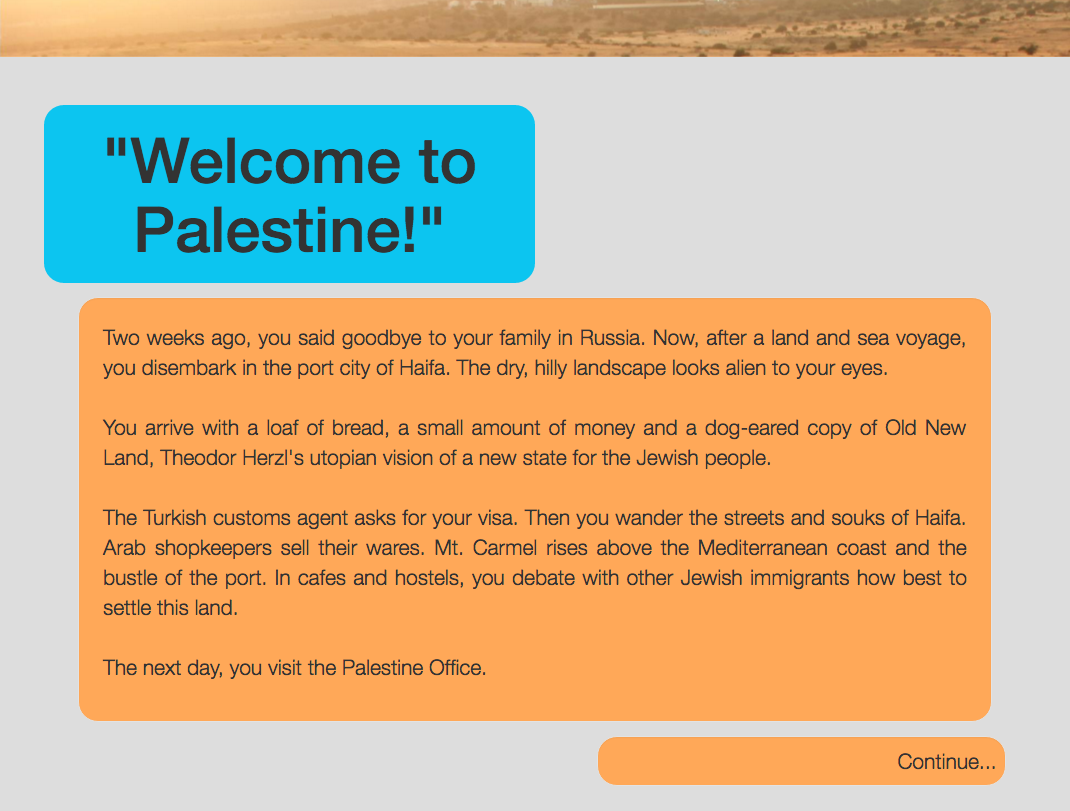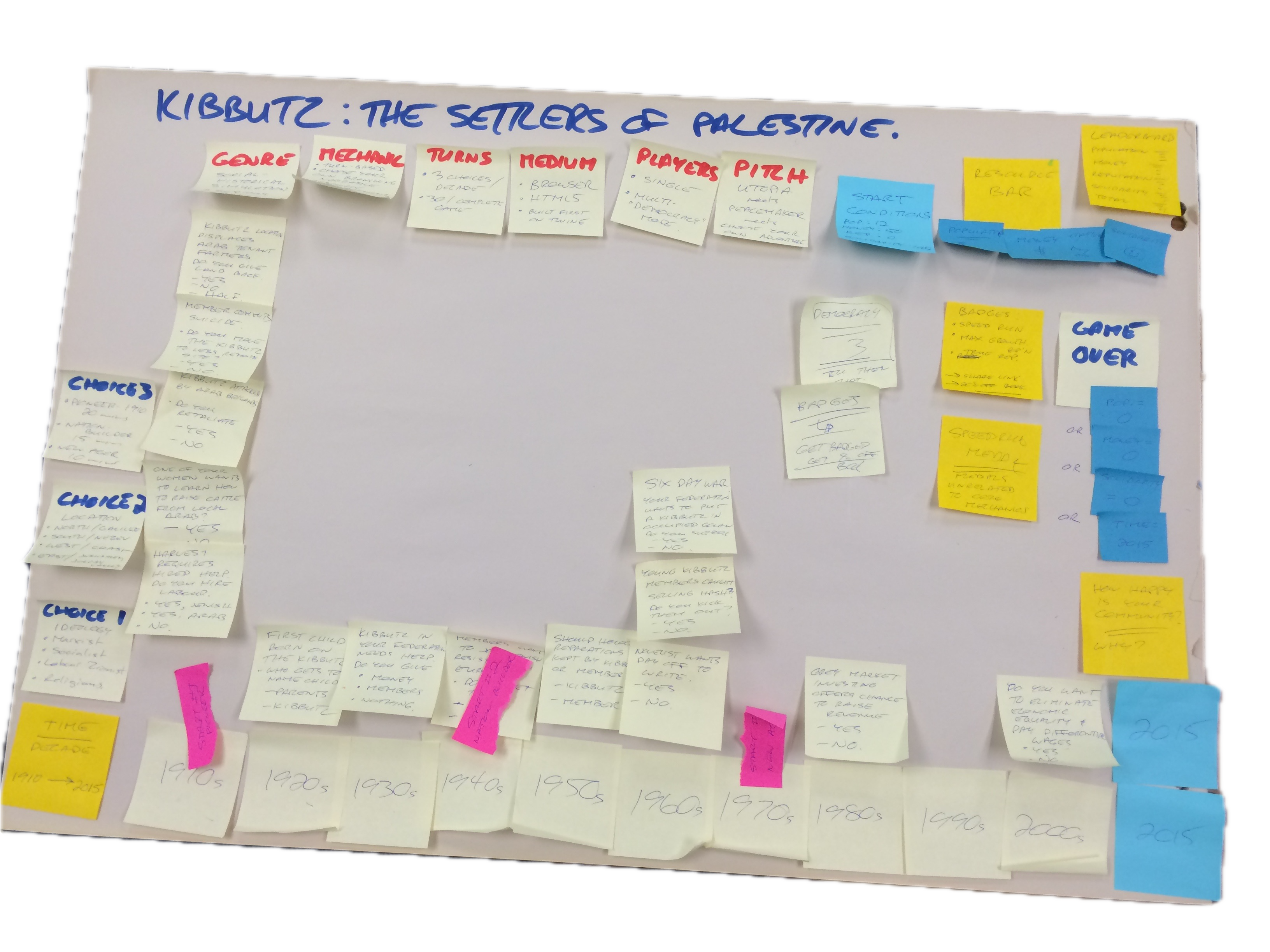Game Design
Kibbutz: The Settlers of PalestineCo-Designers: David Leach (author), Ashley Blacquiere (programmer)
Important Note: I co-designed this online simulation to accompany the 2016 publication of my book Chasing Utopia. The original game was launched in 2017. The eras covered in this virtual history of the kibbutz movement run from 1910 (the founding of kvutza Degania) until roughly 2020, by which time the kibbutz movement had largely faded into the background of Israeli life and influence.
That all changed on October 7, 2023. The terrorist attacks by Hamas and other militants on many kibbutzim (especially Be’eri, Kfar Aza, Nahal Oz and Nir Oz) and other communities in the Western Negev—and the subsequent IDF military response on Gaza—forever altered the trajectory of kibbutz history and the movement’s complex role in the Israeli-Palestinian conflict. (I wrote about the experiences of kibbutzniks on border kibbutzim on and after October 7 for Jewish Renaissance magazine.) Despite the historical significance of October 7 on the kibbutz movement (and elsewhere in Israel/Palestine), I felt it was inappropriate to update this virtual simulation of an imaginary kibbutz given the very real violence and ongoing trauma of that day and its aftermath.
Inspiration: This project was inspired by the work of Ian Bogost on forms of reality-based interactive narratives such as serious games, newsgames and persuasive games, as well as his valuable concept of “procedural rhetoric“. The game PeaceMaker (which allows players to try to negotiate a Two State Solution in the role of the Israeli Prime Minister or the President of the Palestinian Authority) provided a model of how an interactive simulation can engage with a complex political topic in the region without over-simplifying the issues or reducing the citizens of Israel/Palestine to caricatures. I was also motivated by Eric Zimmerman and Heather Chaplin’s “Manifesto for a Ludic Century” to transform the excess research I’d accumulated for my book into a playable “system” that would allow participants to understand from the inside the political and economic challenges and social and ethical compromises of Israel’s kibbutz founders and communal leaders.
Title: Kibbutz: The Settlers of Palestine is a deliberately provocative title. Kibbutz narrows the focus of the game to the history of the Zionist socialist communes established in pre-state and post-independence Israel. Settler has connotations of the religious right-wing settlers whose presence in the occupied West Bank (and previously in Gaza and the Sinai) has been a major obstacle to a Two-State Solution — and acknowledges that the original secular left-wing kibbutzniks were also part of a settlement movement. (They were also the first to establish kibbutzes, after the Six Day War, in the captured Syrian territory of the Golan Heights.) Palestine is, of course, the name for the contested geography claimed by both the Jewish and Palestinian peoples — and the name used by British authorities during the Mandate period of early kibbutz settlement. Finally, Settlers of Palestine evokes Settlers of Catan (later rebranded Catan), the influential “Euro” boardgame, as a reminder that Kibbutz is “just a game” (to be played) and that no game is ever “just a game” (and so should be played critically).
Medium: I designed an original paper prototype for the game in 2014 as part of the Games for Digital Humanists seminar at the Digital Humanities Summer Institute. Early plans to include archival photos, background music, or other multimedia elements were shelved, and I decided instead to make a simple web-based hypertext historical simulation that would be accessible to gamers and non-gamers alike—and easy to design, program and update on a website. I received a grant (after the disbanding of the CCCBE) to establish the Digital Storytelling & Social Simulation Lab and used money to hire Ashley Blacquiere to co-design and code the game. I wrote the text on a word processor, pasted it into an Excel file and then added numerical changes to the main variables based on different choices. Ashley coded the game in Javascript and HTML.
Point of View: The game’s point of view is a standard Choose Your Own Adventure “you” that asks players to imagine themselves as a kibbutznik voting on decisions that affect their evolving community. I decided to leave the “you” a bit vague, as the timeline of the game covers 100+ years and multiple generations of kibbutz history. The “you” is not meant to be only one individual but perhaps a series of kibbutzniks or leaders with shared values. The player is free to project their own identity onto this “you”. From an ideological perspective, the game is told from the point of view of a Zionist community trying to balance establishing a state for the Jewish people with the values of socialist equality and solidarity. The game’s goal is not to argue that kibbutz movement’s socialist and Zionist philosophy is correct—politically, socially, economically or otherwise—but rather to try to understand the motivations and actions, both internally and externally, of the kibbutz from the inside-out. Of course, critics might argue that the game’s procedural rhetoric may be more explicit than I’m admitting to…
Narrative: The game takes players on a speed-run through the first 110 years of the kibbutz movement’s history, from the founding of Degania in 1910 all the way to 2020, when most of the 270 kibbutzim had voted for various forms of privatization and were no longer socialist. After players select an Ideology and location for their kibbutz, the game guides them through 10 key historical eras in pre-state and post-independence Israel. Players face two challenges per era. Fifteen are randomized; five major dilemmas must be faced every time. All the choices are based on real trends or specific issues from kibbutz history. Influenced by the decisions, the rise and fall of different metrics of the community’s “health” (Solidarity, Economy, Population and Reputation) allow players to envision an emergent narrative of how their kibbutz is faring amid the flow of modern Israel’s turbulent history.
Playtesting: Ashley and I presented an early prototype of this of this game at the Canadian Game Studies Association conference, and I demonstrated more complete versions at gatherings of the Society for Utopian Studies and the International Communal Studies Association. Over the years, students in my WRIT 324 Interactive Narratives course have played the game in groups and offered critical comments on its UI and UX.
Design Iteration: The earliest beta version of the design (see right) had a numerical sidebar down the left of the screen marking off a player’s progress through the 10 eras and another sidebar that showed the numerical values of the four main metrics of kibbutz health. We wanted to de-emphasize this focus on a quantitative understanding of community success to focus more on the subjective experience of making difficult decisions, so we removed the numerical sidebars and Ashley designed a rolling line graph that reflects the relative rise and fall of the four variables, with the precise numerical values in much smaller type at the bottom of the screen. He also programmed an algorithm that converts the final values of Population, Economy, Solidarity and Reputation into a spectrum of positive-to-negative adjectives in a summary sentence that describes the kibbutz’s status in 2020…. and allows players to reflect on whether it is a “success” or not.
Core Mechanics: The main form of interactivity in the game is a series of hypertext choices to resolve 20 (mostly) randomized dilemmas faced by the kibbutz’s general assembly. Unlike the architecture of a CYOA book or game, however, these choices do not result in branching narrative paths and alternate storylines. Instead the choices impact the four quantitative metrics of community health, often causing one (or more) variable to go up while others go down. There may also be a bonus (or penalty) to certain variables if the choice aligns (or does not) with the original Ideology selected by players at the beginning of the game. See the Game Tips for how these four different Ideologies operate and the various Lose States that can trigger a Game Over state if the four community health variables drop too low.
Signature Mechanic: The most controversial design element of the game is the “kibbutz voted against you” mechanic. Originally, if Solidarity fell below its starting value of 50, there was a one in four chance any choice you made would be “overruled” by other kibbutz members and replaced by a different decision. Unlucky players could experience successive votes against them… and, in feedback, student playtesters remarked on the frustration of that experience. In game design terms, the player loses “agency” with this mechanic—the ability to affect the game-story in meaningful ways, which is one of the attractions of interactive stories. In thematic terms, I wanted to keep the mechanic because it reflects the experience (and frustration) of living in a community guided by the 50% plus one rule of direct democracy, and the value of group Solidarity to any kibbutz’s success. I felt it worked as an example of “ludonarrative consonance” in which the interactivity (in this case the loss of control) mirrors the story’s themes. We considered adding Easy/Hard modes—one without the mechanic and one with it. Instead, as a compromise, we tweaked the mechanic, so that it is only triggered when Solidarity drops below 40 (which will only happen if you make several choices that lower Solidarity) and added text that accompanies every failed vote explaining that the kibbutz ruled against your choice due to waning Solidarity. Let me know if that improves the experience!
Future Revisions: We revisited the simulation in 2024 and identified a few areas to debug. In once instance, players can be asked in one era if they want to shut down the kibbutz’s children’s house and let kids sleep at home with their parents—and then get asked that same question later in the game, even if they answered yes the first time. Further revisions will focus on re-examining the impact on the four variables of different choices as well as the bonus/penalty for certain Ideologies, to make sure the effects align well with the choices and better balance the game play. (The Religious kibbutz ideology, for instance, has less impact than the other three kibbutz philosophies currently.) We are also considering ways to make the numerical variables of the four community health metrics more realistic or meaningful. One way would be to change the algorithm so that Population does not simply range up and down between zero and roughly 150 but more directly reflects the actual range of kibbutz populations from a dozen (the founding of Degania) to several thousand (the biggest kibbutzim at their peak). Another option would be to remove the numbers for the four main variables entirely at the bottom of the graph and replace each with the algorithmically determined text modifier that appears in the final statement at the end of game (e.g., for Population: enormous, large, medium-sized, small, tiny) so the changes to the community throughout the game play feel more subjective and less quantitative. (A version of this for Reputation was included in our beta version.)
We hope to add more Internal and External dilemmas and choices in each Era to add depth, detail and better reflect the complexity of the experience of the kibbutz movement as a microcosm reflected within the history of Israel. Please feel free to email any suggestions to dleach[at]uvic.ca. Finally, our goal was always to include citation links to sources that explain the background of each of the dilemmas that players face. Originally, we considered clickable pop-up windows within the game, but then we thought that function might distract from the players’ imaginative immersion in the game’s narrative experience. Instead will update this References page [link to come!] as we add a more complete interactive bibliography that will enable the game to be used as an educational resource about the kibbutz movement and in its history.


